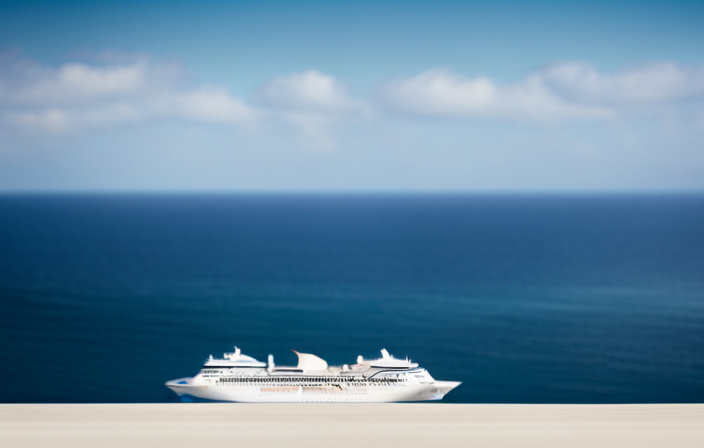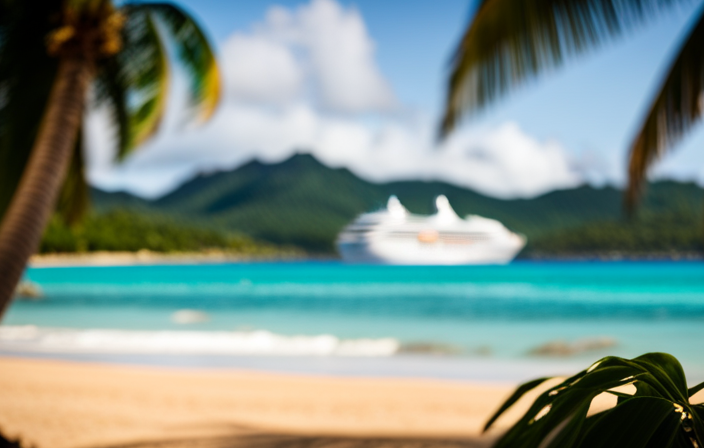Safety is often cited as the most important factor in any mode of travel. When deciding whether to take a cruise or fly, there are numerous factors you must consider to make an informed decision. In this article, we will delve into and tackle the question of safety: is traveling by cruise ship safer than by airplane?
Using a thorough, analytical, and evidence-based approach, we will compare accident statistics, safety regulations, emergency preparedness, structural integrity, evacuation procedures, health and sanitation measures, security protocols, and the role of passengers in ensuring safety.
By examining the safety records of both cruise ships and airplanes, we can gain insights into the potential risks associated with each mode of transportation. Understanding the measures in place for both will shed light on the safety regulations that govern their operations.
Additionally, we will explore the protocols and procedures in place for emergencies, as well as the design and construction of these vessels. Furthermore, we will evaluate the processes for evacuations, the measures taken to prevent illness and disease, and the security measures against potential threats.
So, let’s dive deep into the world of cruise ships and airplanes, and discover which option offers a safer journey for travelers.
Key Takeaways
- Counterterrorism strategies are implemented in both cruise ships and airplanes, including thorough screening processes and collaboration with law enforcement agencies.
- Passengers play a crucial role in ensuring safety by staying informed about safety procedures, being observant of their surroundings, and following instructions from the crew.
- Passenger awareness and crew training are vital components of travel safety, contributing to a safer journey for everyone.
- Factors to consider when choosing the right mode of transportation include maintenance, crew training, pilot experience, and personal preferences, with a focus on prioritizing safety.
Accident Statistics: Comparing Safety Records of Cruise Ships and Airplanes
When it comes to accident statistics, airplanes have a much safer track record than cruise ships. Accident prevention is a top priority in the aviation industry. Airlines adhere to strict maintenance protocols, conduct regular safety trainings, and follow comprehensive security measures. Airplanes are equipped with advanced technology, such as radar systems and weather monitoring tools, to ensure safe flights.
In contrast, cruise ships have had a few high-profile accidents in recent years, raising concerns about their safety record. While cruise ships also undergo safety inspections, the frequency and rigor of these inspections may not match the standards set for airplanes.
Understanding the measures in place for both cruise ships and airplanes will shed light on the differences in their safety regulations. Now, let’s explore the safety regulations for both modes of transportation.
Safety Regulations: Understanding the Measures in Place for Cruise Ships and Airplanes
While traveling by sea or air, you’ll notice the strict safety regulations in effect, creating a web of protection around your journey. These regulations are designed to prioritize accident prevention and ensure the safety of passengers and crew members.
For both cruise ships and airplanes, safety inspections are conducted regularly to check the condition of the vessels and aircraft, as well as to ensure that all safety equipment is functioning properly. Additionally, both industries have implemented robust training programs for their staff members, including emergency drills and simulations.
Safety regulations also dictate the number of lifeboats and life rafts required on board, as well as the placement of fire extinguishers and emergency exits. By adhering to these regulations, both cruise ships and airplanes continually work to enhance safety measures and provide a secure travel experience.
Looking ahead, let’s explore emergency preparedness and examine the safety protocols and procedures in place.
Emergency Preparedness: Examining Safety Protocols and Procedures
During your journey, take comfort in knowing that emergency preparedness is a top priority. Safety protocols and procedures are in place to ensure your well-being. Both cruise ships and airplanes conduct regular emergency drills to familiarize passengers and crew members with evacuation procedures and safety measures. These drills are crucial in preparing everyone onboard for any potential emergencies that may arise.
Additionally, both modes of transportation are equipped with advanced communication systems. These systems allow for swift and effective communication during emergencies. This ensures that all relevant parties are informed and can respond promptly to any potential threats.
Moving forward, it is important to analyze the design and construction of cruise ships and airplanes. This analysis helps to further understand the measures in place to ensure structural integrity and safety for passengers and crew members.
Structural Integrity: Analyzing the Design and Construction of Cruise Ships and Airplanes
Take a closer look at the intricate craftsmanship and sturdy foundation of these floating cities and soaring birds to truly appreciate the unwavering commitment to your safety and security. Both cruise ships and airplanes are meticulously designed and constructed to ensure structural integrity.
However, there can be design flaws and differences in construction materials that may impact safety. For cruise ships, design flaws could include inadequate or poorly located lifeboat stations, while airplanes may have weaknesses in the fuselage or wings.
Construction materials, such as steel and aluminum alloys, are carefully selected to withstand the pressures and stresses of their respective environments. These materials undergo rigorous testing to ensure their durability and ability to withstand extreme conditions.
Understanding the design flaws and construction materials of both cruise ships and airplanes is crucial in evaluating their safety.
Now, let’s delve into evacuation procedures and evaluate the processes for emergency situations.
Evacuation Procedures: Evaluating the Processes for Emergency Situations
In emergency situations, the evacuation procedures of both cruise ships and airplanes are carefully evaluated to ensure the swift and efficient removal of passengers. Evaluating the effectiveness of these procedures is crucial in order to minimize the potential risks and hazards associated with emergency situations. One way to assess the effectiveness of evacuation procedures is through emergency drills, which simulate real-life scenarios and allow for the identification of any weaknesses or areas of improvement. These drills provide valuable insights into how well passengers and crew members are able to respond and evacuate in a timely manner. By analyzing the results of these drills, cruise ship and airplane operators can make necessary adjustments to their evacuation procedures to enhance safety. Transitioning into the subsequent section about weather conditions, it is important to consider the impact of weather on the overall safety of both cruise ships and airplanes.
Weather Conditions: Considering the Impact of Weather on Safety
Weather conditions have a significant impact on safety, especially for cruise ships and airplanes. Climate change has led to more frequent and unpredictable extreme weather events like hurricanes, storms, and heavy fog. These conditions can pose risks to transportation by affecting visibility, stability, and maneuverability. Fortunately, technology advancements have improved safety measures. Advanced radar systems, weather prediction models, and communication systems allow for better monitoring and navigation during adverse weather. However, it’s important to recognize that weather still plays a crucial role in safety considerations. In the next section, we will discuss health and sanitation measures to prevent illness and disease.
Health and Sanitation: Exploring the Measures to Prevent Illness and Disease
In terms of safety, it is important to consider not just the impact of weather conditions, but also the measures taken to prevent illness and disease on both cruise ships and airplanes.
When it comes to health and sanitation, cruise ships have implemented stringent measures to ensure the well-being of their passengers. They have implemented measures against food contamination, such as regular inspections of their kitchens and strict hygiene protocols for food handling. Additionally, cruise ships have also taken extensive measures to prevent viral outbreaks by implementing thorough cleaning and disinfection procedures, as well as providing hand sanitizers throughout the ship. These measures are crucial in maintaining a healthy environment for passengers.
Moving forward, it is essential to explore the security measures in place on both cruise ships and airplanes to ensure the safety of passengers against potential threats.
Security Measures: Discussing Safety Measures Against Potential Threats
To ensure a secure and protected environment, both cruise ships and airplanes have implemented comprehensive security measures against potential threats.
In today’s digital age, cybersecurity measures are crucial in safeguarding the systems and networks of these modes of transportation. Cruise ships and airlines have invested in advanced technology and protocols to prevent cyber attacks and protect sensitive passenger information.
Additionally, both industries have implemented counterterrorism strategies to mitigate the risk of terrorist activities. This includes thorough screening processes, trained security personnel, and collaboration with law enforcement agencies.
By continuously evaluating and enhancing these security measures, cruise ships and airplanes aim to provide passengers with a safe and secure travel experience.
Moving forward, it is essential to highlight the role of passengers in ensuring safety, as they play a vital part in adhering to security protocols and reporting any suspicious activities.
Passenger Responsibility: Highlighting the Role of Passengers in Ensuring Safety
Passenger responsibility plays a crucial role in ensuring safety during travel. Studies have shown that passenger vigilance is essential for enhancing overall travel safety. To contribute to a safer travel experience, passengers can follow these four key ways:
-
Stay informed: Take the time to familiarize yourself with safety procedures, emergency exits, and evacuation plans. Being aware of these important details can make a significant difference in case of an emergency.
-
Be observant: Pay attention to your surroundings and fellow passengers. If you notice any unusual behavior or suspicious items, it is crucial to report them immediately to the crew or authorities. Your vigilance can help prevent potential threats.
-
Follow instructions: During safety drills and emergencies, it is important to cooperate with the crew’s instructions. Following their guidance can ensure a coordinated and efficient response to any safety situation that may arise.
-
Attend safety briefings: Take advantage of the safety briefings offered before or during your journey. These briefings provide crucial information about onboard safety measures and can equip you with the knowledge needed to respond effectively in case of an emergency.
Passenger awareness and crew training are vital components of travel safety. By actively participating in safety measures, passengers can contribute to a safer journey for everyone. Considering these factors is important when making an informed decision about the safest mode of transportation.
Making an Informed Decision: Weighing the Factors and Choosing the Right Mode of Transportation
Consider the various factors and prioritize your safety as you weigh your options for traveling. When choosing transportation, it’s crucial to take into account the specific factors that contribute to safety.
For example, in the case of cruise ships, factors such as the ship’s maintenance, crew training, and adherence to safety regulations play a significant role. On the other hand, when it comes to airplanes, factors like pilot experience, aircraft maintenance, and the airline’s safety record are essential considerations.
Additionally, it’s important to consider the mode of transportation that aligns with your personal preferences and risk tolerance. While both cruise ships and airplanes have safety measures in place, it’s crucial to do research, gather information, and make an informed decision that suits your needs and comfort level.
By weighing these factors carefully, you can choose the mode of transportation that provides the highest level of safety for your journey.
Frequently Asked Questions
What are the most common types of accidents that occur on cruise ships and airplanes?
When it comes to accidents, both cruise ships and airplanes have their fair share. Common causes include human error, mechanical failures, and unpredictable weather. Safety measures, like crew training and maintenance checks, aim to prevent such mishaps.
How do safety regulations for cruise ships and airplanes differ?
Safety regulations for cruise ships and airplanes differ in several ways. Both industries have strict regulations, but enforcement and compliance may vary. Training, accident investigation, and emergency response protocols are crucial for passenger and crew safety.
What are the emergency preparedness protocols for cruise ships and airplanes?
Emergency response training and communication systems are critical for both cruise ships and airplanes. Crew members undergo rigorous training to handle emergencies, and advanced communication systems are in place to ensure rapid response and coordination during crises.
How do the design and construction of cruise ships and airplanes contribute to their structural integrity?
Design factors and construction materials play a crucial role in ensuring the structural integrity of both cruise ships and airplanes. How do these factors contribute to their strength and safety? Let’s dive in and find out.
What are the specific evacuation procedures for cruise ships and airplanes in emergency situations?
In emergency situations, both cruise ships and airplanes have specific evacuation procedures in place to ensure passenger safety. These procedures are part of their emergency preparedness plans and are designed to efficiently evacuate all passengers and crew members.
Are Cruise Ships Safer Than Airplanes?
When it comes to determining safety, comparing cruise ships and airplanes can be difficult. However, by following some vital tips for choosing cruise cabins, passengers can ensure a comfortable and secure voyage. Considering factors like location, accessibility, and emergency exit routes are crucial in selecting a cabin that meets individual safety preferences onboard a cruise ship.
Conclusion
After analyzing the accident statistics, safety regulations, emergency preparedness, structural integrity, evacuation procedures, health and sanitation measures, security measures, and passenger responsibility, it is evident that both cruise ships and airplanes prioritize safety.
However, when it comes to making an informed decision, it is essential to consider personal preferences and factors such as destination, duration, and comfort.
Ultimately, the choice between a cruise ship and an airplane should be based on individual needs and preferences.
Alfons is the visionary leader and driving force behind Voyager Info’s success. As the Editor in Chief, he brings a wealth of experience and an unwavering passion for travel to the helm of our cruise-centric platform.
With a lifelong fascination for exploring new horizons, Alfons discovered his love for the ocean and cruising at a young age. From sailing across pristine Caribbean waters to embarking on daring expeditions to far-flung destinations, he has amassed a treasure trove of first-hand experiences in the world of cruising.











